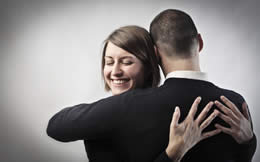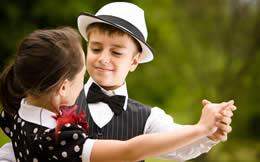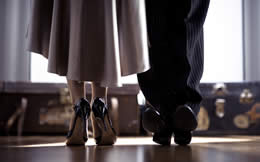Connection is a much debated topic in tango. It’s what it’s all about in the end, isn’t it? A warm, gentle embrace, moving to the music as one… These instants of pure bliss come about by magic – the right partner, the right music, the right moment… However, technique can help and ensure that you get more of these memorable tandas, these beautiful “tango moments” as we like to call them.
From a technique standpoint, a stronger connection comes from both partners’ ability to create and maintain two closed loops: one horizontal and one vertical.
- The horizontal loop: it’s the embrace, the “communication central”, how information is passed from one partner to the other. A good horizontal loop is one which is comfortable and conducive to an efficient transfer of information both ways.
- The vertical loop: the use of the floor, how both dancers gradually transfer their weight using the floor as a resounding board, hence providing constant feedback to one another about one’s position.
Here are a few tips about how to improve both “connection loops”.
The embrace – the horizontal loop
The best way to describe a nice embrace is to see it as a balanced, closed loop of energy and information. To achieve this, a few technique points definitely help:
 |
Tip 1 – Create a rounded embrace with a circular energyIn the embrace, the energy should be circular. This means that both partners should try and go around one another with their arms, as if hugging one another. Imagine hugging your partner, and then extend one arm to build the embrace. This will give you an idea of what a nice embrace with a pleasant, rounded energy should feel like. |
Leaders sometimes put pressure on their partner’s back by squeezing their right hand too tightly. This is not that great as it prevents followers from activating their back muscles and it also disrupts the rounded energy we’re trying to create. So leaders, try and release the pressure of your back hand to experience a more rounded connection.
 |
Tip 2 – Use firmness and not tensionTo create a stable embrace, it is best to activate muscles around the shoulder blades. This creates a strong, steady yet gentle embrace, necessary to maintain the arms in place. Using biceps creates a much sharper energy which is quite unpleasant and can be tiring. As a rule of thumb, if your shoulders and biceps are aching after dancing, you’re not using the right muscles. |
When building the embrace, you should instead feel that your shoulder blades are coming apart and almost sticking outwards as if they were being pulled away from one another.
 |
Tip 3 – The extended armThis is the side of the “loop” that we mostly pay attention to. To maintain the right connection, it is important for both partners to keep a gentle pressure towards one another at all times and not pull one another’s hand. Followers sometimes have a floppy right arm, which makes it difficult for them to perceive the lead in time. In this case, strengthening the grip on the right arm will definitely help improve the connection – always with a rounded energy. |
One really good exercise to help you use constant pressure without pulling is to build the embrace and keep the fingers of the extended hands straight and not close them on one another’s hand. Then neither of you can pull!
Tip 4 – The closed side of the embrace
It is quite common to focus a lot of attention on the extended side of the embrace, and forget a bit about the closed side. Putting some firmness on that side of the embrace however will greatly enhance the connection. Leaders sometimes move this arm up and down too much – besides it looking not so good (chicken wings anyone), it also destabilises the follower, who at times feels the support of the leader’s arm and at times doesn’t. Followers on their side sometimes forget to establish a contact and leave their arm up in the air.
So for both partners, putting more firmness on the closed side of the embrace will definitely help strengthen the connection, by closing the energy loop and creating a balanced embrace with both arms equally engaged.
The floor – the vertical loop
Imagine that the vertical loop runs between the leader’s feet, his torso, the follower’s torso and her feet. This loop is activated when both partners use the floor properly to move and transfer their weight gradually. To get a feel for this transfer of energy, you can try:
Tip 5 – How to activate the loop
When building the embrace, try and push your heels into the floor. If you’ve done yoga before, this will feel familiar to you. Imagine you want to anchor yourself into the floor. This will provide you some support and grounding to grow tall and strong.
 |
Tip 6 – How to maintain the connectionMaintaining the connection means to slide on the floor when dancing. So instead of lifting your feet to go from point to the other, try instead to gently slide into the floor, trying to maintain the connection with the floor. Most people slide along the floor with the first leg they extend but then forget to do the same with the second leg, when collecting. Remember, both legs play an equal role in tango, so try and keep both firmly anchored on the floor. |
We hope these tips are useful. If you have any questions or comments, don’t hesitate to get in touch!
See you soon on the dancefloor,
Nati and Bruno











